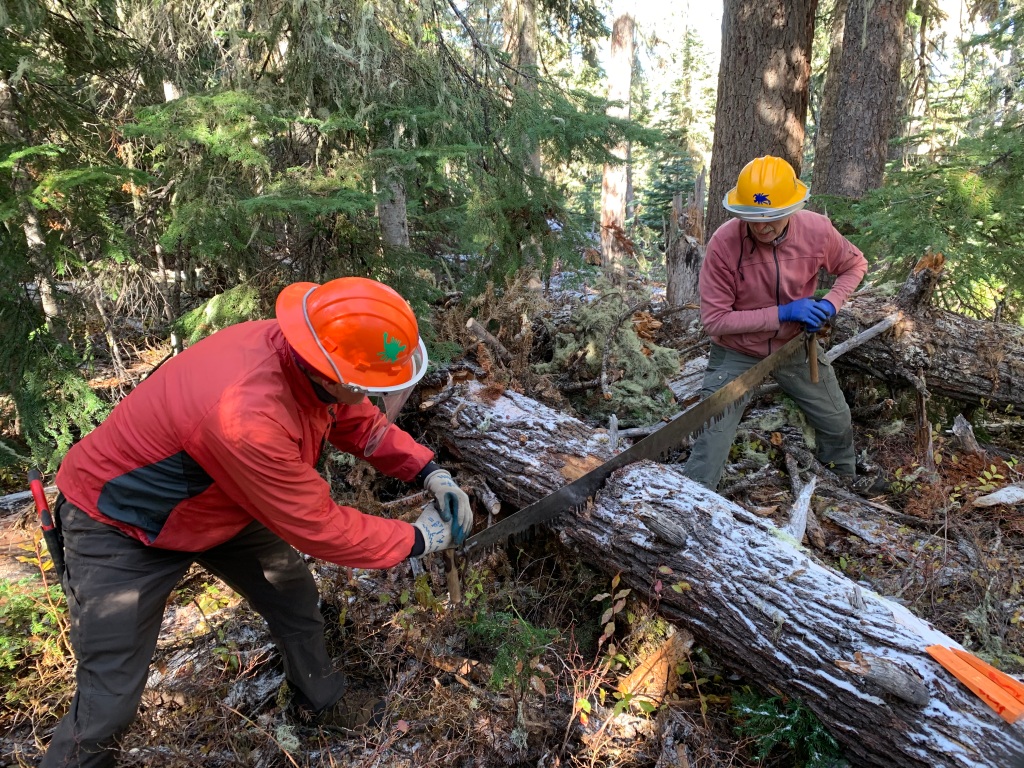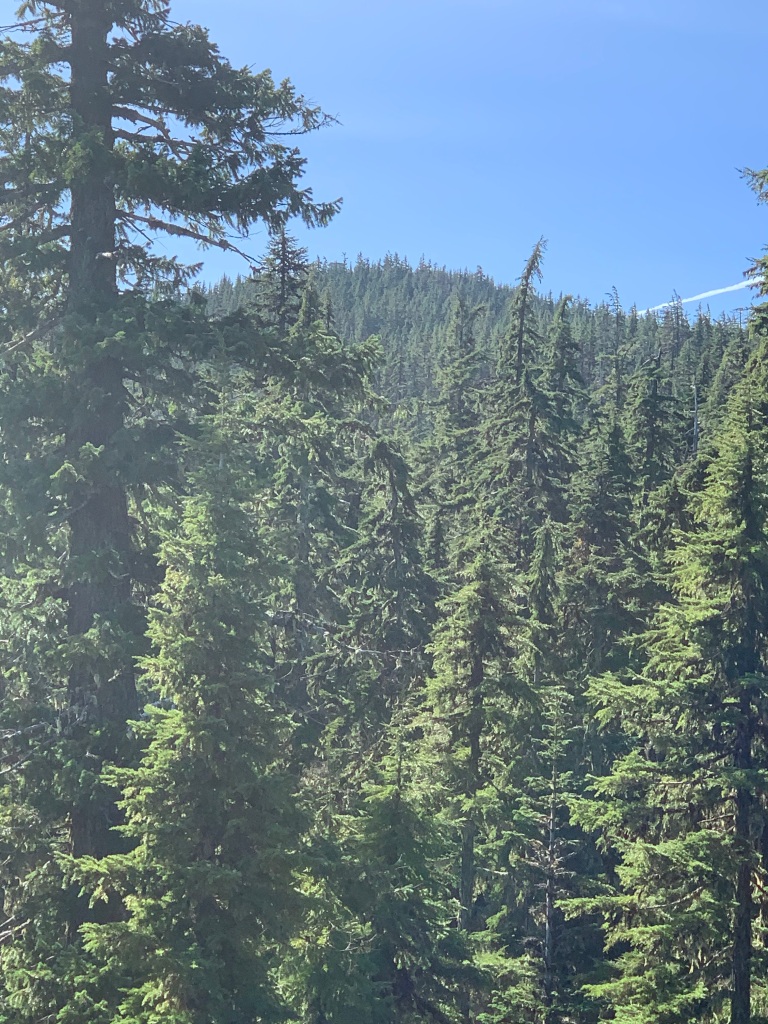I should be colder than this, I thought, standing on the frozen dirt road with a thin coating of snow. I’ve got jeans on, 2 shirts, and a thin windbreaker. It was 27 (or -3 C), and I had my back to a brisk wind that so far had not worked its way through my balaclava or under my hard hat.
One way to Winchester Ridge Trail was downhill to to Swan Lake then climbing out, steeply in places, to the ridge. Others had told me the bushwhack from the parking lot directly to the trail was flat and we’d get to the ridge in about a half mile. I looked upward at the route and had my doubts, as we gathered our tools and headed east on to a trail that quickly disappeared.
My GPS showed several contours in our direction, so I assumed the worst—that the contours were real and what I had heard wasn’t—and noted my altimeter. I estimated at least 400 vertical feet—120 meters— of climbing. Some think that sort of knowledge is not part of the wilderness experience, but I have long used an altimeter when I hike, along with maps, which most definitely are part of the wilderness experience. I want to know where I am, where I am going, about how far it is, and how much I have to climb or descend. Altitude on a trail can often be a surrogate for one’s location, if there are good contour maps. The trail was gone, the trees angled up, the bushes scraped my jeans and left a coating of snow. At least hiking uphill, I was staying warm, so long as I didn’t fall. Fortunately, Winchester Ridge Trail came earlier than what my Gaia app told me, and I didn’t have to cross two more brown contour lines. We were on the trail, heading south towards Waldo Mountain junction, about 2.5 miles away. We didn’t know what was out there, log-wise, but we’d find out in about a half hour, when we reached the previous stopping point.
I have my watch altimeter and my Gaia contours set to metric. My GPS reads English. My car speedometer and odometer is set to metric. I didn’t think I would keep it that way, but I do. Making a meter of elevation is a lot better than a foot (nearly 3.03 times as better), and I play around with the numbers on the trail, the way I look at the rocks, trees, sky, and wildlife. To me, being in the outdoors is a full mental experience.
I had all my essentials except for a lot less water than I carried in summer, which was a blessing. I usually carry a Pulaski without a sheath. Sometimes, there is one, but it tends to come off if I am going through brush, and putting the sheath on and off again several times, I finally decide it’s easier to carry it without one. If I start to slip, I am supposed to throw the tool, assuming my flailing arm in an attempt to balance me is capable to doing that on short notice. The first time I was hiking out with the Crew, I threw it on one bounce into the calf of the guy in front of me. Fortunately, nothing happened, but I felt stupid and apologized. That’s why one should follow well behind on the trail.
We reached the first log, and as I in the rear approached, the two working on it waved us on to the next one, 20 yards further down the trail. As I came up to the log, I scouted the area using the acronym OHLEC—Objective-Hazards-Lean/Bind (we weren’t tree fellers, so only bind mattered)-Escape route-Cutting Plan. The first log was across the trail, 12 inches in diameter, too long to try to pull it parallel to the trail, but it had promise that with one cut, we could pull the remaining end to the side. There were no significant hazards, the log would probably have top bind, but not severe, the escape routes weren’t an issue for a log near the ground, and we opened the cut slightly to accommodate our later pushing of the log to the desired direction. My partner and I, both of us newly certified to do what we had already been doing all summer— the previous year as well— for that matter, bent to the task, or the saw.
The top bind or compression wasn’t enough to catch the saw, and we cut through the log quickly. I kneel a lot on the ground, because I prefer the ground to bending over, and I think I cut better with the saw closer to eye level. Besides, my back is happier that way.
We stopped briefly to let the first cutter crew go through on to the next log, and then finished the cut, put a strap around the log, stepped back, and pulled the remainder parallel to the trail. It was done. I now was quite warm and took off my windbreaker.
We headed on, leapfrogging, to the next log, 20 inches in diameter, in a pile of branches. I call these things a mess. In order to figure out what to do, we had to first remove the branches, some of which had 3 inch trunks of their own and were both difficult to cut and to throw aside. Once we got the area cleared, we looked at the log and decided we probably would get away with one cut, but might need two.
As we started cutting, the saw moved well. Sawdust was being generated, I allowed my partner to take as much of the saw as he wanted, and I pulled back as far as I could. Each stroke counted more that way. Half way through, there was a little bind. I pulled a hard plastic wedge out of my pocket, stuck it in the kerf, or the cut, and pounded it in with the back of the axe. The stuck saw was resting against my leg, and as I pounded it, I could feel it start to move, as the bind was relieved.
We cut further, and as we got near the end, we slowed the cutting speed and shortened the arc. The sawdust became reddish, as we entered the bark, and we stopped sawing. While we could cut through, the log might take the saw into the ground, and dirt is one of the worst enemies of a vintage cross cut saw. I removed the handle, and my partner pulled the saw through the cut, then replacing the handle.
I finished the cut with my KatanaBoy 500, a one man saw, and while that shouldn’t touch the ground either, it is less easily damaged than a large crosscut and also replaceable, unlike the vintage crosscuts, which were handmade with different steel that no longer exists. The log dropped slightly. Because of the ease of the cut, we decided to make a second cut, figuring that we could do it almost as fast as trying to rig up a way to move the log. I like moving logs and saving a cut, but I have my limits.
We would later have lunch on a splendid rock overlook with Waldo Lake in the distance to our east and the Eddeeleo Lakes below us. We would finish the trail in sunshine—although still cool—and split up the crew on the way back, some re-taking the “shortcut” back down to the cars, others, like me, taking two trails, one that descended, the second ascending to the cars.
Our way was 4 minutes faster.




Leave a comment